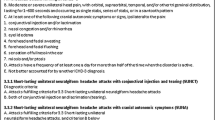Abstract
Purpose of Review
In this review, we examine reported cases of cephalgia alopecia including the initial case report from 2006. The goal is to review the clinical description, pathophysiology, diagnosis, and treatment of cephalgia alopecia.
Recent Findings
The pathophysiology of the headache and hair loss in cephalgia alopecia is believed to be related to neuroregulation of skin and nerve. It is hypothesized that the headache causes recurrent activation of trigeminal and upper cervical branches that innervate the hair cells. The repetitive activation of C fibers results in depletion of substance P and calcitonin gene-related peptide (CGRP), which leads to loss of hair growth promotion and disruption of immune system regulation. A case report suggests that cephalgia alopecia and nummular headache with trophic changes may represent a spectrum of disease involving head pain and cutaneous changes.
Summary
Cephalgia alopecia is a rare headache disorder described as recurrent burning, stabbing head, and neck pain that is followed by hair loss in the corresponding region of the scalp. The mainstay treatment for both pain and hair loss is OnabotulinumtoxinA (onabotA). A patient’s clinical history and response to onabotA treatment is used to make the diagnosis. Future research is needed to examine the hypothesized disease continuum of head pain and cutaneous changes. It will also be beneficial to assess if the grid-like onabotA technique used in nummular headache is effective in cephalgia alopecia. In addition, further studies are needed to assess the proposed pathophysiology.
Similar content being viewed by others
References
Papers of particular interest, published recently, have been highlighted as: • Of importance •• Of major importance
Cutrer FM, Pittelkow MR. Cephalalgic alopecia areata: a syndrome of neuralgiform head pain and hair loss responsive to botulinum a toxin injection. Cephalalgia. 2006;26(6):747–51.
•• Irimia P, Palma JA, Idoate MA, España A, Riverol M, Martinez-Vila E. Cephalalgia alopecia or nummular headache with trophic changes? A new case with prolonged follow-up. Headache. 2013;53(6):994–7. This case report suggests the possibility that cephalgia alopecia and nummular headache represent a disease spectrum of cephalgia and cutaneous changes.
Cutrer FM, Sandroni P, Wendelschafer-Crabb G. Botulinum toxin treatment of cephalalgia alopecia increases substance P and calcitonin gene-related peptide-containing cutaneous nerves in scalp. Cephalalgia. 2010;30(8):1000–6.
Martín JM, Montesinos E, Cordero P, Gonzalez V, Ramon D. Trichoscopy features of trichotillomania. Pediatr Dermatol. 2019;36(2):265–7.
Simakou T, Butcher JP, Reid S, Henriquez FL. Alopecia areata: A multifactorial autoimmune condition. 2018.
Gupta AK, Carviel JL, Foley KA, Shear NH, Piraccini BM, Piguet V, et al. Monotherapy for alopecia areata: a systematic review and network meta-analysis. Ski Appendage Disord. 2019;5(6):331–7.
Siebenhaar F, Sharov AA, Peters EMJ, Sharova TY, Syska W, Mardaryev AN, et al. Substance P as an immunomodulatory neuropeptide in a mouse model for autoimmune hair loss (alopecia areata). J Invest Dermatol. 2007;127:1489–97.
Wang F, Millet I, Bottomly K, Vignery A. Calcitonin gene-related peptide inhibits interleukin 2 production by murine T lymphocytes. J Biol Chem. 1992;267(29):21052–7.
• Wilhour D, Ceriani CEJ, Nahas SJ. Nummular headache. Curr Neurol Neurosci Rep. 2019;19(6):26. This review discusses the grid-like onabotA technique used for the treatment of nummular headache. Our article discusses the possibility of extraprolating this technique in treating cephalgia alopecia.
Mathew NT, Kailasam J, Meadors L. Botulinum toxin type a for the treatment of nummular headache: four case studies. Headache. 2008;48(3):442–7.
Author information
Authors and Affiliations
Corresponding author
Ethics declarations
Conflict of Interest
Kate O. Bedrin declares no conflict of interest.
Carrie Dougherty declares no conflict of interest.
Human and Animal Rights and Informed Consent
This article does not contain any studies with human or animal subjects performed by any of the authors.
Additional information
Publisher’s Note
Springer Nature remains neutral with regard to jurisdictional claims in published maps and institutional affiliations.
This article is part of the Topical Collection on Uncommon and/or Unusual Headaches and Syndromes
Rights and permissions
About this article
Cite this article
Bedrin, K.O., Dougherty, C. Cephalgia Alopecia. Curr Pain Headache Rep 24, 46 (2020). https://doi.org/10.1007/s11916-020-00880-w
Published:
DOI: https://doi.org/10.1007/s11916-020-00880-w



